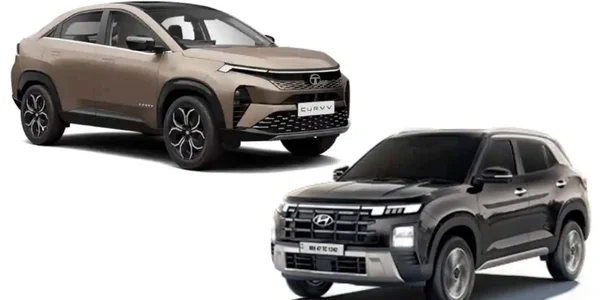As the Indian automotive market accelerates towards electrification, two prominent manufacturers, Hyundai and Tata Motors, are poised to introduce their latest electric SUVs: the Hyundai Creta Electric and the Tata Curvv EV. Both models aim to capture the burgeoning demand for eco-friendly vehicles, offering distinct features and specifications tailored to the evolving preferences of Indian consumers.
Design and Aesthetics
The Hyundai Creta Electric retains the robust and upright stance characteristic of its internal combustion engine (ICE) counterpart, the Creta. This conventional SUV silhouette is complemented by modern design elements, including connected LED headlights and tail lights, and a front center charging port. Notably, the Creta Electric is equipped with 17-inch wheels fitted with 215-section tires and features a digital key and active air flaps, enhancing both functionality and appeal.
In contrast, the Tata Curvv EV adopts a more avant-garde approach with its coupe-like sloping roofline, exuding a European design ethos. The vehicle boasts flush door handles, 18-inch wheels with 215-section tires, and all-LED lighting, including fog lights with a cornering function. These design choices contribute to a futuristic and sleek appearance, setting the Curvv EV apart in the electric SUV segment.

Interior Features and Technology
Inside the cabin, the Tata Curvv EV is outfitted with dual 12.3-inch screens serving as the infotainment system and instrument cluster. The vehicle offers ventilated front seats, a 360-degree camera, blind-spot monitoring, a premium audio system, a panoramic sunroof, an advanced driver-assistance system (ADAS) suite, telematics, and a powered driver’s seat. These features underscore Tata’s commitment to providing a tech-rich and comfortable driving experience.
Similarly, the Hyundai Creta Electric is equipped with dual 10.2-inch screens, ventilated front seats, and a suite of advanced features, including a 360-degree camera, blind-spot monitoring, premium audio, a panoramic sunroof, ADAS, telematics, and a powered driver’s seat. While both vehicles offer a comprehensive array of modern amenities, the Curvv EV’s larger screens may appeal to tech-savvy consumers seeking enhanced display interfaces.
Performance and Battery Specifications
Under the hood, both SUVs feature front-wheel-drive configurations powered by electric motors. The Tata Curvv EV accelerates from 0 to 100 km/h in approximately 8.6 seconds, supported by two battery pack options: 45 kWh and 55 kWh, delivering an ARAI-certified range of up to 585 km. However, Tata has recently revised these figures, indicating a maximum range of up to 502 km.
The Hyundai Creta Electric, on the other hand, achieves 0 to 100 km/h in about 7.9 seconds, slightly edging out the Curvv EV in acceleration. It offers battery capacities of 42 kWh and 51.4 kWh, with a claimed range of up to 473 km. In terms of charging capabilities, the Creta Electric supports an 11 kW AC charger, surpassing the Curvv EV’s 7.2 kW AC charging support. Despite this, Tata asserts that the Curvv EV offers faster DC charging, potentially reducing downtime during long-distance travel.
Pricing and Market Positioning
The Tata Curvv EV is priced between ₹17.5 lakh and ₹22 lakh (ex-showroom), positioning it competitively within the mid-range electric SUV segment. Hyundai is expected to adopt an aggressive pricing strategy for the Creta Electric, potentially offering it at a similar or slightly lower price point to attract a broader customer base. Additionally, Hyundai’s extensive network of over 10,000 charging stations across India and the established reputation of the Creta nameplate, with over 1.1 million customers, may provide it with a competitive advantage in terms of brand trust and after-sales support.
Conclusion
Both the Hyundai Creta Electric and Tata Curvv EV bring compelling propositions to the Indian electric SUV market. The Creta Electric appeals to consumers favoring a traditional SUV design coupled with Hyundai’s expansive service network, while the Curvv EV attracts those inclined towards innovative design and cutting-edge interior technology. Prospective buyers should consider their individual preferences, performance expectations, and the importance of brand legacy when making an informed decision between these two promising electric vehicles.